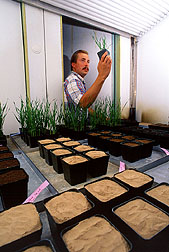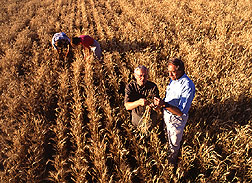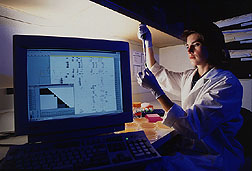Premier Bacteria Suppress Wheat Take-All
|
|
It was the fifth consecutive time that plant pathologists Jos M. Raaijmakers and David M. Weller grew wheat seedlings in soil they'd collected from Lind, Washington. The soil was special, but not unique—similar soils had been found worldwide. These soils, on which only wheat had grown year after year, naturally suppressed the fungus that causes one of the world's worst wheat diseases: take-all.
The scientists, working for USDA's Agricultural Research Service, were trying to identify why wheat thrived in these soils when, in most places, it succumbed to the ravages of take-all. The Gaeumannomyces graminis fungus blackens plant roots and can reduce yields by 50 percent or more, costing U.S. wheat growers millions of dollars annually.
Weller is a plant pathologist in the ARS Root Disease and Biological Control Research Unit at Pullman, Washington. Raaijmakers, formerly a plant pathologist with ARS, is now an assistant professor at Wageningen University in the Netherlands.
The researchers succeeded—and more. They discovered that specific strains of bacteria possess extraordinary abilities to reproduce on roots and fight the disease. Their discoveries not only give new hope for take-all control, they may have broad applications for biological control of many diseases in a variety of crops.
Natural suppression of take-all was first observed more than 60 years ago. If a wheat crop was grown every year and no other crops were grown in the same soil, the disease would eventually disappear—or exist only at very low levels. This phenomenon was labeled "take-all decline."
By the 1970s, several scientists, including ARS researchers, knew that fluorescent Pseudomonas bacteria were somehow involved.
A decade ago, retired ARS plant pathologist R. James Cook (now with Washington State University), Weller, and ARS geneticist Linda S. Thomashow discovered a key to the role of the pseudomonads. They proved that some of these bacteria produce antibiotics and showed that the antibiotics naturally suppress the G. graminis fungus. And they isolated the genes responsible for producing the antibiotics 2,4-diacetylphloroglucinol (Phl) and phenazine-1-carboxylic acid (PCA).
The scientists also successfully transferred the antibiotic-producing ability to other Pseudomonas strains. [For a brief history of important research about take-all and its control, see Tackling Wheat Take-All, Agricultural Research, August 1995, pp. 4-7.]
These findings opened the door to using the bacteria as a biological control for take-all. But there were still questions. Although take-all decline occurred worldwide, there were enough differences that scientists believed many mechanisms were involved.
And using the Pseudomonas bacteria to suppress take-all presented a challenge common to all biological control efforts: how to achieve consistent success.
"Usually, you start with very large numbers of a biological control organism, such as a million on each plant seed," says Weller. "But as the control organisms compete with the hundreds of other soil microbes for nutrients, their population declines sharply. That gives the fungus a chance to regain a foothold."
Three Candidates Are Standouts
Weller's team discovered that nature provided the solution. In three Washington soils that naturally suppress take-all, they've identified three different bacteria that outperform all the other microbes. "At least in the U.S. Pacific Northwest, there seems to be just one mechanism for take-all control," says Weller.
These bacteria have a specific genetic fingerprint that indicates superior abilities.
"These premier strains have two unique qualities that have never been seen in any biological control agent. They colonize the wheat's roots very aggressively, and they control disease when applied in relatively low numbers."
Unlike other bacteria, the populations of these premier strains decline much less from competition with other organisms. Even starting with only 10,000 bacteria on a seed, the premier strains reproduce rapidly and soon reach the level of millions necessary to suppress take-all. And they stay at that level throughout the growing season.
The bacteria's ability to reproduce so rapidly has an enormous cost-savings potential. "Every factor of 10 by which you decrease the dose, or number of organisms applied—say from 1,000,000 to 100,000 organisms—significantly reduces the cost of the biological control treatment," says Weller. ARS has applied for a patent on the premier bacterial strains, the genetic fingerprint, and the methods for finding similar strains in other soils. Two companies plan to license the technology to produce seed coatings or other control methods. Farmers should start to reap the benefits in just a few years.
"With these strains, it is possible to control disease on as many as 1,000 acres with only a quart of bacterial culture," says Weller.
The scientists have demonstrated that in 2 to 6 years of cropping only wheat, the bacteria's presence can change the soil from an environment that favors take-all to one that naturally suppresses it.
Each soil may have a different bacterium that works best, but all these premier bacteria possess the same qualities. The next step is to find the actual genes responsible for their root-colonizing abilities. In the meantime, the researchers can enhance the bacteria by using genetic technology they developed earlier.
The premier strains already produce the Phl antibiotic. "By adding a gene, we can transform the bacteria so they also produce the antibiotic PCA, while retaining their strong reproductive and competitive abilities," says geneticist Thomashow.
Strains that produce both antibiotics fight two other important root diseases, Rhizoctonia root rot and Pythium root rot. These diseases cost millions of dollars annually in lost yields and control chemicals.
The transgenic bacteria are also more potent. Only 100 to 1,000 of them are needed per seed, compared with the 10,000 of the premier strain or the 1,000,000 typically used now for other biological control bacteria. Thomashow and Weller are already testing the transgenic organisms in the field, with approval from the U.S. Environmental Protection Agency.
Even though they're powerful, they're safe. "There's no worry that the bacteria will take over," says Thomashow. "They only thrive as long as the wheat is growing, and they are part of the natural ecosystem already."
Once these bacteria become commercially available, cereal and turfgrass growers will definitely benefit. But the researchers believe the findings have a much broader application.
"We've illustrated that there is a biochemical and molecular basis for biological control, and this should apply to a wide variety of diseases and crops," says Thomashow.
The technology, she says, is generic. So far, each suppressive soil they've examined contains a premier strain. "Take-all decline has been studied extensively, but other instances of diseases naturally declining in the environment have been recorded."
Weller is especially hopeful that the technique may be a boon to strawberry growers as a replacement for methyl bromide. This fumigant has been essential for strawberry growers to combat soilborne diseases, but it is scheduled for elimination in the year 2005. Tomatoes, watermelon, and peas are other likely crops to investigate.
"In each crop we've looked at so far, there appears to be a premier strain. This may be a universal phenomenon," Weller says.—By Kathryn Barry Stelljes, Agricultural Research Service Information Staff.
This research is part of the ARS National Program on Plant Sciences described on the World Wide Web at http://www.nps.ars.usda.gov/programs/cppvs.htm.
David M. Weller and Linda S. Thomashow are in the USDA-ARS Root Disease and Biological Control Research Unit, 365 Johnson Hall, Washington State University, Pullman, WA 99164-6430; phone (509) 335-1116, fax (509) 335-7674."Premier Bacteria Suppress Wheat Take-All" was published in the March 1999 issue of Agricultural Research magazine.









